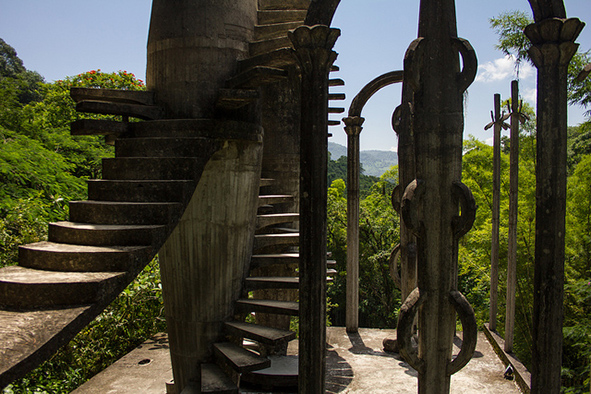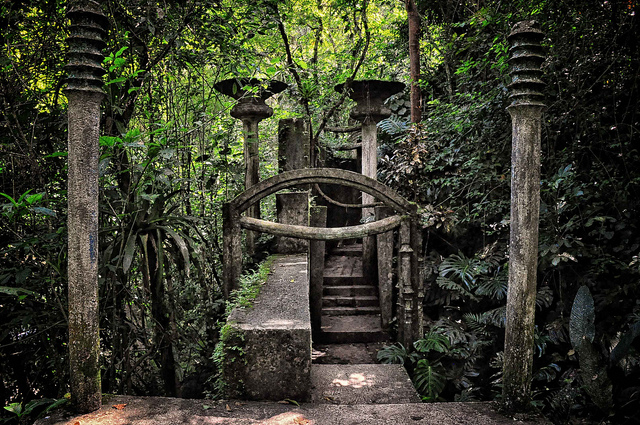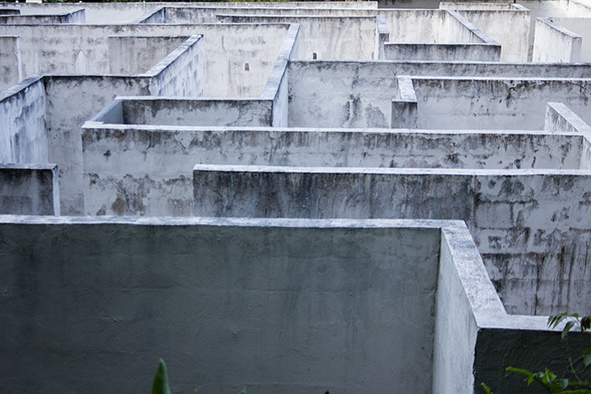Lost somewhere in the deepest reaches of the Mexican jungle is the surrealist playground of Sir Edward James. Its giant concrete sculptures are enthralling, occasionally beautiful and downright bizarre.

Stairways to the sky. (Photo: Rosa Menkman)
It was one of those rainy evenings in Mexico City when you can feel the water pumping through your hair. I was stood with a friend on a balcony watching traffic wade across the streets below, discussing how much I enjoyed being one of a small number of Brits living in Mexico.
“In a way I think I just like to be different,” I said.
“Different?! But there are loads of British people here!” my friend snapped back at me. “Sir Edward James – now he was different.”
“Who?!”
And so my friend unravelled the great legend of Sir Edward James, a British aristocrat whose story seemed so unlikely that it just had to be true. James, disillusioned with the life of the rich and wealthy in post-war Britain and heavy with the heartache of a failed marriage, had dropped everything, abandoned his estate, and fled to the depths of the Mexican jungle where he set about constructing his personal Eden.
“For better or worse, that man really left his mark on the Mexican landscape,” my friend said. “So you’ve got a lot to live up to”.
La Huasteca Potosina
La Huasteca Potosina isn’t the most accessible place in the world. I’d had the bright idea of travelling overnight, which meant twelve hours of sitting next to a twitchy five year old pumped up with sweets. As our bus crawled its way up into the mountains through curtains of meaty fog, all I could do was lie back, close my eyes, and dream of walking through the jungle.
Eight hours later, I arrived in Aquismon: a pretty place of one-story plaster houses and open doors. It was hot and I was struggling to resist the urge to sleep.
I quickly found a hotel, but the desk was unattended. I toyed with the idea of just reaching behind the wooden desk and grabbing a room key, but lethargy won the day and I propped myself against the counter, sweating on a surprisingly large variety of tourist leaflets.
I finally rang the bell and waited for about five minutes before a surly man, with his t-shirt rolled up just above the paunch, waddled up alongside me.
“Can I have a room, please?” I asked, barely able to get the words out of my mouth.
He said nothing, pulled a huge bunch of keys out of his pocket and waddled off down a dark corridor.
“Do you know anything about Sir Edward James?” I called after him.
The man stopped and stood still.
“Sir Edward James?” he slurred.
“Yeah, some English bloke who lived around here.”
“Ahhh … Xilitla!”
“Yes, Xilitla!”
“My brother, he take you,” he said booting open the door of a darkened room with a malfunctioning fan.
Twelve hours later and I was on my way, rattling around in the back of a Toyota pickup.

Sculptures at Edward James’s Xilitla (Photo: Rod Waddington)
Concrete Jungle
No matter how long I’d spent imagining Xilitla, nothing I could have created would have lived up to the bizarre majesty of Sir Edward James’s jungle painting.
“Something in my nature obliges me to be eccentric,” James once said of himself. No kidding.
James had started out growing exotic plants, travelling hundreds of miles to collect the most unusual species. He later moved on to animals, reptiles and birds. At one point the enigmatic Englishman arrived at a hotel in Mexico City with two recently-acquired (and hungry) boa constrictors. James proceeded to rent adjoining suites, before letting the giant snakes loose, together with a sack of live mice. The mice escaped, of course, at which point a frightened American tourist accosted a staff member and asked what on earth mice were doing in such a reputable establishment. The hotel employee replied: “These aren’t the hotel’s mice. They belong to the fool with the two boa constrictors in the room next to yours.”
After a freak frost killed off many of his most unique plants, James resolved to etch something a little more permanent onto his jungle canvass. As a lover of the surrealist movement, it only seemed right to go with the most absurd thing he could think of: giant concrete sculptures.
Xilitla is like little else. Few could have dreamt it up, let alone spent the time and money actually creating it.
As I stepped out of the truck and walked downhill into the heat of the forest, I could just about make out the weeping grey of the rotting concrete swimming in a sea of deep green. Staircases, towers and enormous concrete flowers jutted out through the trees, climbing out of the desperate grip of the forest and disappearing into the low-hanging clouds – great monuments to one man’s desire for legacy, or perhaps just to his artistic whim. I trod carefully, trying to make sense of it all, confused as to where the jungle ended and James’s imagination began.

Dusk from Xilitla. (Photo: Rosa Menkman)
I walked along paths and stairways, under swooping archways and beneath ornate buttresses into concrete rooms and platforms. There was no logic to the design and architecture. I was just going round in circles. I stopped walking and closed my eyes to drown myself in the jungle, gulping down the sounds of monkeys, insects and birds. I could hear animals playing among the trees and the playful flutter of flowing water. I was truly far from home.
I eventually found a pool of water reflecting the ghostly beauty of James’s garden. I stepped out into the liquid glass and let myself float on its comforting belly, absorbing the absurdity of Sir Edward James’s elaborate design and watching the clouds float in among the trees.
James never expected to finish the garden and somehow that makes the place even more fascinating, as the vines and shoots continue to entangle themselves around the concrete jungle, reclaiming a space that was once solely theirs. The whole thing is alive – impossibly grander than James may ever have envisaged.
Other tourists began to join me in the cool water.
“Where are you from?” a Mexican man asked me.
“I’m British,” I beamed.
“Wow … so you must know Sir Edward James’s family!” he said with a smile on his face.
“Yeah, why not.”
Leaving the water behind, I wound my way up the highest of the staircases, trying desperately not to look down at the drop to the jungle below – there was no side or barrier to break my fall if I happened to slip on the moist concrete. I just focused on my breathing and took one step at a time. When I reached the peak, I sat contemplating the shifting sheets of grey and green beneath me and recalled a quote by James’s good friend, the poet John Betjeman: “The sun that shines on Edward James shines also down on me.”
Thanks to his ludicrous imagination and his artistic audacity, the sun that shined on Edward James will surely flood the Mexican jungle for quite some years to come.

The maze of Xilitla. (Photo: Rosa Menkman)